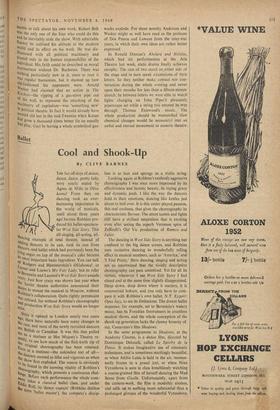Ballet
Cool and Shook-Up
By CLIVE
BARNES THE far-off days of dance, dance, dance, pretty lady, were nearly ended by Agnes de Mille in Okla- homa! From then on dancing took an ever- increasing importance in the world of musicals, until about three years ago"Jerome Robbins pro- duced his ballet-spectacu- lar West Side Story. This all-singing, all-acting, all- (Lancing example of total theatre, instead of ,.,""ding dancers to its cast, took its cast from dancers, and ballet which had previously been the icing sugar on top of the musical's cake became 'Ls Most important basic ingredient. You can talk „el Rodgers and Hammerstein's Oklahoma!, or Lerner and Loewe's My Fair Lady, but to refer to Bernstein and Laurent's West Side Story sounds ,e,razy. Just how crazy was shown last year when `,11e Soviet theatre authorities announced their desire to mount the musical in Moscow, without Robbins's collaboration. Quite rightly permission was refused, for without Robbins's choreography " Production West Side Story would no longer Since it opened in London nearly two years :Bo, there have naturally been many changes in are east, and most of the newly recruited dancers 4re British or Canadian. It was this that pulled roe to a matinee at Her Majesty's Theatre re- ntly, to see how much of the flick-knife zip of ;le original choreography has been retained. „yen at a matinee—the unkindest test of all— the dancers seemed as lithe and vigorous as when t0 be first exploded. The reason is obviously et. °e found in the teeming vitality of Robbins's le.,Eoreugroy, choreography, which presents a continuous chal- 2Be. Before each performance the whole corn- :4,11Y takes a classical ballet class, and under the Roll, its 'dance captain' (Robbins dislikes le term 'ballet master'), the company's discip- line is as taut and springy as a violin string.
Looking again at Robbins's restlessly aggressive choreography I was once more impressed by its effectiveness and laconic beauty, its loping grace and dynamic push. I like the way the dancers hold in their emotions, dancing like kettles just about to boil over. It is this under-played passion, this real coolness, that gives the choreography its characteristic flavour. The street scenes and fights still have a stylised naturalism that is exciting even after seeing the superb Veronese spivs of Zeffirelli's Old Vic production of Romeo and Juliet.
The dancing in West Side Story is anything but confined to the big dance scenes, and Robbins uses recitative dancing to wonderfully telling effect in musical numbers, such as 'America,' and `I Feel Pretty.' Here dancing, singing and acting ate so intertwined that the vividly descriptive choreography can pass unnoticed. Yet for all its virtues, whenever I see West Side Story I feel elated and at the same time slightly disappointed. Deep down, deep down where it matters, it is commercial hokum, and you only have to com- pare it with Robbins's own ballet, N.Y. Export: Opus Jazz, to see its limitations. The dream ballet sequence, for example, set to Bernstein's watery music, has its Freudian forerunners in countless musical shows, and the whole conception of the shook-up generation lacks the clumsy honesty of. say, Cassavates's film Shadows.
In the same programme as Shadows, at the Academy Cinema, is a dance film, directed by Dominique Delouch, called Le Spectre de la Danse. It makes imaginative use of cinematic techniques, and is sometimes startlingly beautiful, as when Attilio Labis is held in the air, momen- tarily frozen in a grand jete, or when Nina Vyroubova is seen in class breathlessly watching a coarse-grained film of herself dancing the Mad Scene from Giselle. Unfortunately, apart from the camera-work, the film is modishly aimless, and adds up to nothing more substantial than a prolonged glimpse of the wonderful Vyroubova.














































 Previous page
Previous page